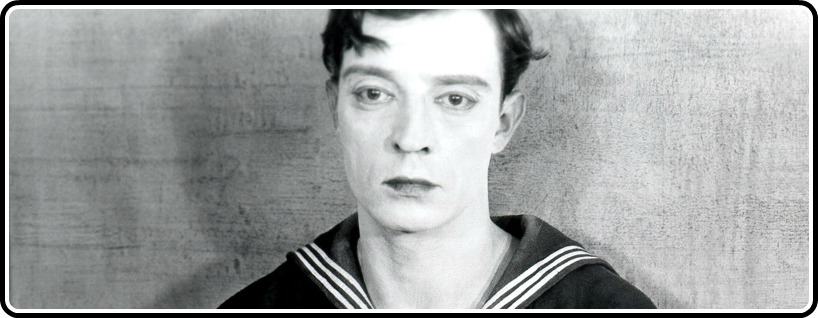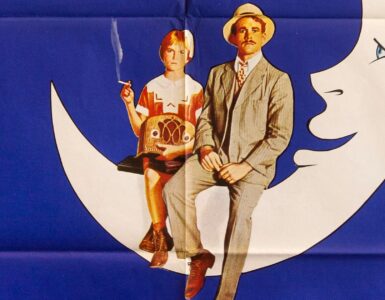When an artist is as prolific as was a man like Buster Keaton, various themes or in the case of films like The Navigator, central ideas and plot points, will slowly arise rather routinely. Be it his love for aquatic entities (water vessels and bodies of water were prevalent throughout his career’s early days) or character archetypes (one would, in any overview of his canon, see the spoiled rich child of money turned stoned face lover more than once or twice) Keaton would revisit various themes and topics throughout his career.
Take the aforementioned hour-long classic for example.
The Navigator, an admitted ancestor to Keaton’s best film, The General, follows the story of a ‘pampered youth’ who is thrust onto a giant vessel known as The Navigator. Joined only by a young beauty, Keaton’s Rollo Treadway is a close cousin to Keaton’s characters from films like The Saphead (read a review of that film HERE) as well as his underrated masterwork Battling Butler (a review of that film can be read HERE) simply tossed inside of a film that blends romance, drama, comedy and even some horror aspects into an hour-long masterpiece of surreal action filmmaking. Now available on Blu-ray through Kino, The Navigator was not only Keaton’s highest grossing and most well received film up to that time, but it may very well be one of his most important and influential films, as well as being a film that he himself held in the highest regard.
Keaton, as a filmmaker (credited as co-director with Donald Crisp), is as important to this film’s success as Keaton is to it as a performer. Taking various cues from different genres and mashing them into the body of a barely feature-length comedy, The Navigator would not only later be seen as a favorite within the surrealist movement that it found itself a precursor to, but is also one of the action genre’s greatest epics. Similar in scope to The General, Navigator‘s conclusion is still, to this day, one of the greatest set pieces in cinematic history, blending the absolute purest form of slapstick comedy with genuinely thrilling stunt work and some gorgeous visuals.
With Keaton, there comes a certain detail to his comedy. Be it his ability to use a giant boat for a lengthy gag, his use of visual gags like the revealing of a word or the pompous nature with which his character feels like he should be driven around, or most importantly his detailed slapstick gags, Keaton was an artist of details. Take a gag found near the end of the film for example. His character, under attack by a group of headhunters, is found with a small canon attached via a rope to his foot. Wherever he goes, the canon is always pointed right at him, the stakes and tension amped up to the highest level possible. However, just when you think all is lost, he ducks out-of-the-way at just the perfect time, not a second too early, nor too late. It’s a brilliant sequence, and one that is a microcosm of just how brilliant a filmmaker and a comedic thespian the icon truly was. As surreal a film as it is comedic, The Navigator is still to this day one of Keaton’s most vital, most important and most influential masterworks.
Taking cues from films like Seven Chances for the first act, Keaton ultimately turns the film into a horror comedy for much of the second act, with the third a full-blown action film, all proving his aptitude with the blending of genres and tone. While keeping the same, stone-faced expression on his person throughout nearly the entire film, Keaton is somehow able to take the viewer on a rollercoaster ride of emotion, from the comedic opening sequence of Keaton walking across a street after being driven the same distance to one of the most chilling underwater sequences you’ll find. The chemistry between he and co-star Kathryn McGuire is great, the greatest example of how Keaton’s female characters were rarely just a prop, as he was often accused of, and their sequence near the middle of the film is both truly tense, while also being moving and comedic.
And Kino again knocks this release out of the park. Not only giving the release a stunning update in its gorgeous transfer, but also returning the film to its original state via a newly restored color-tinted transfer, something Keaton had originally intended the film to feature, Kino makes this a truly great Blu-ray. A commentary is featured here with historians Robert Arkus and Yair Solan, as is a making of featurette written by Bruce Lawton. The release is stacked with great features, and while it may seem not all that shocking that we hear at The CriterionCast have fallen for a Kino Buster Keaton release, the company again proves that it is definitely in the conversation as one of the best home entertainment companies running, even giving Criterion’s work on the Chaplin canon a run for its money.






![Bergman Island (The Criterion Collection) [Blu-ray]](https://criterioncast.com/wp-content/uploads/2022/11/bergman-island-the-criterion-collection-blu-ray-400x496.jpg)
![This Is Not a Burial, It’s a Resurrection (The Criterion Collection) [Blu-ray]](https://criterioncast.com/wp-content/uploads/2022/11/this-is-not-a-burial-its-a-resurrection-the-criterion-collection-blu-ray-400x496.jpg)
![Lars von Trier's Europe Trilogy (The Criterion Collection) [The Element of Crime/Epidemic/Europa] [Blu-ray]](https://criterioncast.com/wp-content/uploads/2022/11/lars-von-triers-europe-trilogy-the-criterion-collection-the-element-of-400x496.jpg)
![Imitation of Life (The Criterion Collection) [Blu-ray]](https://criterioncast.com/wp-content/uploads/2022/11/imitation-of-life-the-criterion-collection-blu-ray-400x496.jpg)
![The Adventures of Baron Munchausen (The Criterion Collection) [4K UHD]](https://criterioncast.com/wp-content/uploads/2022/11/the-adventures-of-baron-munchausen-the-criterion-collection-4k-uhd-400x496.jpg)
![Cooley High [Criterion Collection] [Blu-ray] [1975]](https://criterioncast.com/wp-content/uploads/2022/11/cooley-high-criterion-collection-blu-ray-1975-400x496.jpg)